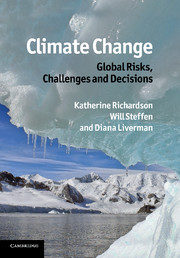Book contents
- Frontmatter
- Contents
- Writing team
- Foreword
- Preface
- List of acronyms and abbreviations
- Part I Climatic trends
- 1 Identifying, monitoring and predicting change in the climate system
- 2 The oceans and the climate system
- 3 Sea-level rise and ice-sheet dynamics
- 4 Carbon cycle trends and vulnerabilities
- Part II Defining ‘dangerous climate change’
- Part III Equity issues
- Part IV Mitigation and adaptation approaches
- Part V Meeting the challenge
- Index
- Plate section
- References
2 - The oceans and the climate system
Published online by Cambridge University Press: 04 April 2011
- Frontmatter
- Contents
- Writing team
- Foreword
- Preface
- List of acronyms and abbreviations
- Part I Climatic trends
- 1 Identifying, monitoring and predicting change in the climate system
- 2 The oceans and the climate system
- 3 Sea-level rise and ice-sheet dynamics
- 4 Carbon cycle trends and vulnerabilities
- Part II Defining ‘dangerous climate change’
- Part III Equity issues
- Part IV Mitigation and adaptation approaches
- Part V Meeting the challenge
- Index
- Plate section
- References
Summary
‘Water water every where nor any drop to drink…’
As described in Chapter 1, the oceans represent, by far, the largest reserve of heat energy found at the surface of the Earth. They also are instrumental in the transport and redistribution of heat on the planet. Thanks, for example, to the North Atlantic Current – which transports heat from tropical regions northwards – residents in the western reaches of Northern Europe experience much warmer temperatures than inhabitants living at the same latitudes in Siberia or northern Canada. Climate change can potentially disrupt some of the current systems that transport heat, thus drastically influencing regional climate patterns (Chapter 7).
In addition to storing and transporting heat, the oceans contain more than 97% of the water on our planet. This means they comprise the dominant component of the Earth's water cycle (‘hydrological cycle’) which, itself, is critical for the functioning of the climate system. As noted in Chapter 1, water vapour is the most important greenhouse gas, and rainfall patterns are an obvious and direct way in which the functioning of the climate system impacts on human societies. The sheer volume of water in the oceans (approximately 1370 million km3) and the response of this mass of water to global warming makes a significant contribution to sea-level rise (Box 1.3 and Chapter 3), as warm water simply occupies a larger volume than cold water.
- Type
- Chapter
- Information
- Climate Change: Global Risks, Challenges and Decisions , pp. 30 - 49Publisher: Cambridge University PressPrint publication year: 2011

